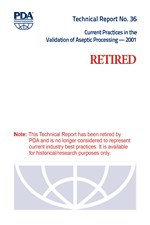PDA Technical Report No. 36, (TR 36) Current Practices in the Validation of Aseptic Processing - 2001 (single user digital version)
Premium Members: to claim your annual free technical document download, email membership@pda.org and indicate the document you wish to claim.
- Format
- PDF Single user
- Member Price
- $50.00
- Nonmember Price
- $100.00
- Government Price
- $50.00
Please sign in or become a member to purchase items from the PDA bookstore.
Note: This Technical Report has been retired by PDA and is no longer considered to represent current industry best practices. It is available for historical/research purposes only.
The validation of aseptic processing continues to be a major area of interest within the pharmaceutical industry. Five years have passed since the last PDA survey on this subject. While there have been no new broadly applicable regulations or regulatory guidance since that time, there has been continued controversy over the details of aseptic processing and process simulation practice.
Industry practices largely adhere to current regulations and guidelines on aseptic processing by the:
- European Union (1),
- ISO (2),
- and FDA (3).
The impact of PDA`s TR No. 22
on Process Simulation Testing for Aseptically Filled Products (4) is also apparent. The Pharmaceutical Manufacturers Association (now PhRMA) in 1979 (5) and PDA in 1986 (6), 1992 (7), and 1996 (8) conducted surveys on this subject that have provided a clearer understanding of contemporary industry practice. This survey addresses the continuing need to track industry practices in the validation of aseptic processing as it evolves.
The survey was prepared, distributed, and compiled by Dr. James Agalloco, Dr. James Akers and Mr. Russell Madsen.
Available to download
Format: PDF (1 file 0.97 MB)
Click here for the digital downloading instruction and Terms of Usage.
Table of Contents
Table of Contents:
- Introduction
- PDA 2001 Aseptic Processing Survey
- Release/Quarantine Practices
- Frequency
- Methods
- Growth Promotion Studies
- Incubation of Process Simulation Samples
- Personnel Monitoring
- Environmental Monitoring, Aseptic Processing
- Environmental Monitoring, Media Fills
- Suspension Products
- Sterile Semi-Solid Products
- Freeze Dried Products
- Sterile Dry Powder Products
- Research & Development (Clinical Trial Material)
- Isolation/Barrier Technology
- Microbial Levels for Controlled Areas
- Terminal Sterilization and Aseptic Processing
- Aseptic Processing Technology
- Other Issues
- Conclusion
- Acknowledgements
- References

